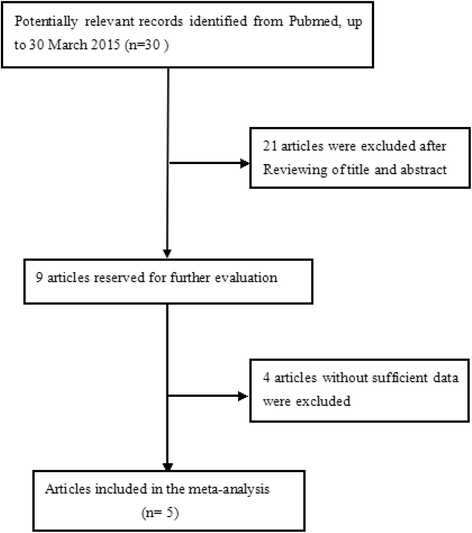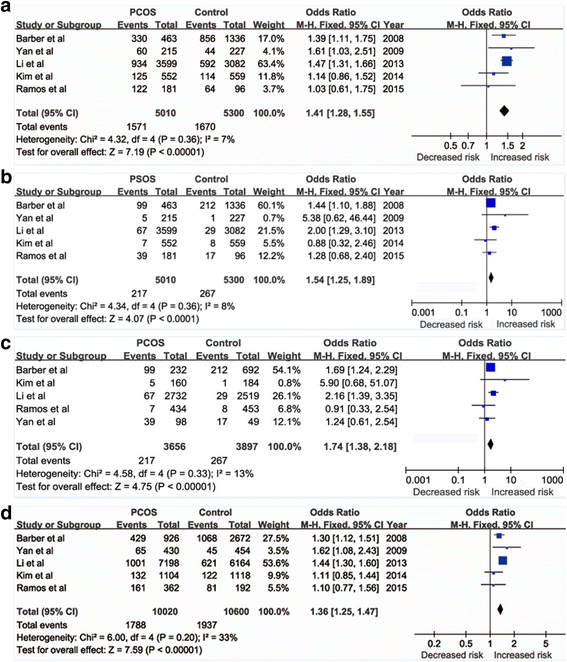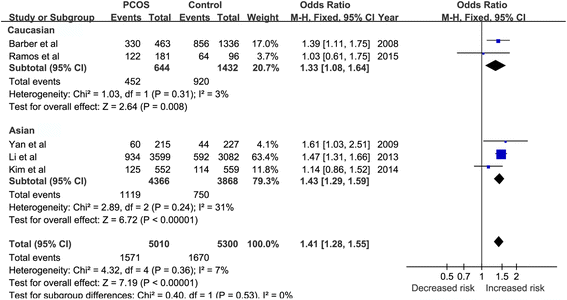Association between fat mass and obesity associated (FTO) gene rs9939609 A/T polymorphism and polycystic ovary syndrome: a systematic review and meta-analysis
- PMID: 28826396
- PMCID: PMC5563909
- DOI: 10.1186/s12881-017-0452-1
Association between fat mass and obesity associated (FTO) gene rs9939609 A/T polymorphism and polycystic ovary syndrome: a systematic review and meta-analysis
Abstract
Background: Up to now, numerous case-control studies have reported the associations between fat mass and obesity associated (FTO) gene rs9939609 A/T polymorphism and polycystic ovary syndrome (PCOS), however, without a consistent result. Hence we performed current systematic review and meta-analysis to clarify the controversial results.
Methods: Case-control studies reporting the relationship of rs9939609 A/T polymorphism and PCOS published before April 2015 were searched in Pubmed database without language restriction. Data was analyzed by Review Manager 5.2.
Results: A total of five studies involving 5010 PCOS patients and 5300 controls were included for further meta-analysis. The results of meta-analysis showed that the FTO gene rs9939609 A/T polymorphism was significantly different between PCOS group and control group in different gene models (For AA + AT vs. TT: OR = 1.41, 95% CI = 1.28-1.55, P < 0.00001. For AA vs. AT + TT: OR = 1.54, 95% CI = 1.25-1.89, P < 0.0001. For AA vs. TT: OR = 1.74, 95% CI = 1.38-2.18, P < 0.00001. For A vs. T: OR = 1.36, 95% CI = 1.25-1.47, P < 0.00001, respectively) suggesting that A allele was a risk factor for PCOS susceptibility. Furthermore, subgroup analysis in Asian and Caucasian ethnicities also found significant association between rs9939609 A/T polymorphism and PCOS (In Asian subgroup: OR = 1.43, 95% CI = 1.29-1.59, P < 0.0001. In Caucasian subgroup: OR = 1.33, 95% CI = 1.08-1.64, P = 0.008) CONCLUSION: This meta-analysis suggests that rs9939609 A/T polymorphism of FTO gene is associated with PCOS risk, and that A allele is a risk factor for PCOS susceptibility simultaneously.
Keywords: FTO; Meta-analysis; Polycystic ovary syndrome; Polymorphism.
Conflict of interest statement
Ethics approval and consent to participate
The manuscript has been read and approved by all the authors. The research adhered to the tenets of The Declaration of Helsinki. The Ethics Committee of Nanhua-Xinghui Hospital approved the protocol. Written informed consent was obtained from all participants among these cited references (12–16).
Consent for publication
Not applicable.
Competing interests
The authors declare that they have no competing interests.
Publisher’s Note
Springer Nature remains neutral with regard to jurisdictional claims in published maps and institutional affiliations.
Figures




References
-
- Stein IF, Leventhal ML. Amenorrhea associated with bilateral poly-cystic ovaries. Am J Obstet Gynecol. 1935;29:181–191. doi: 10.1016/S0002-9378(15)30642-6. - DOI
Publication types
MeSH terms
Substances
LinkOut - more resources
Full Text Sources
Other Literature Sources
Medical
Miscellaneous

